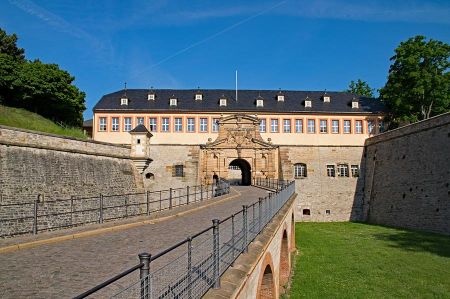Citadel on the Petersberg - a highlight when visiting Erfurt
- Written by Portal Editor
On the occasion of the citizens' festival for German Unity Day, we visited the Petersberg Citadel in the city centre of Erfurt for the first time, arranged in a star shape on the Petersberg and rising above Erfurt's old town.
The citadel was considered impregnable when it was completed, so it was a military project that also used existing structures from the former Erfurt royal palace and was completed in the middle of the 17th century as a baroque city fortress.
Some basic information for your visit:
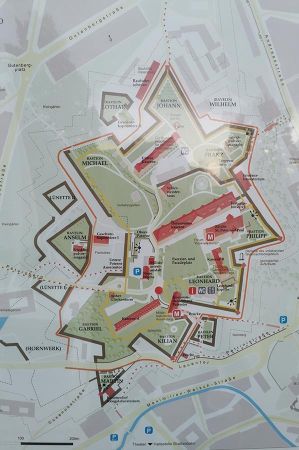 Address: Petersberg, 99084 Erfurt, info@petersberg-erfurt.de, +49 361 6640170, click here for the website!
Address: Petersberg, 99084 Erfurt, info@petersberg-erfurt.de, +49 361 6640170, click here for the website!
Distance to public transport: 600 meters (tram), we recommend using the parking options on the outskirts of the city and changing to public transport and / or bringing bicycles with you.
Parking garages nearby: Domplatz parking garage, Bechtheimer Straße 1, 99084 Erfurt
Playground Seating Play corner / play area, information, pets allowed, free entry, open to the public
Digital offers: App for mobile devices
Mobility offers: Bicycle stands / boxes
Sanitary facilities: Disabled toilet Toilet
Photography: Photography allowed
Today, when visiting the citadel, you can explore the new exhibition in the commandant's house and the listening galleries in the strong walls of the fortress or simply enjoy the fantastic view over Erfurt's old town, which we now often do in order to visit the small, manageable shops in the old town beforehand or afterwards. To ensure that as many sections of the Petersberg Citadel as possible are available to all guests, access to the fortress grounds has been completely redesigned. A passenger elevator on the fortress wall to the upper plateau makes it easier to climb. The panoramic path, which begins at Domplatz, also makes it possible to reach the citadel independently and without any additional aids.
Our tour of the citadel on Petersberg
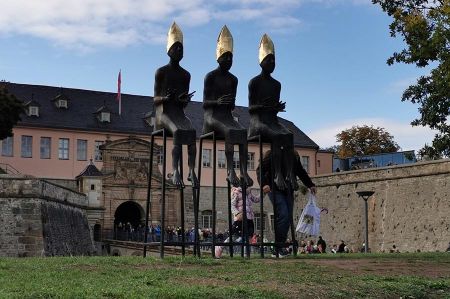 Despite the existing lift up to Petersberg, we use the staircase on Petrinistrasse up to one of the largest, but at least the only, largely preserved baroque city fortress in Central Europe, which we would like to compare with Palmanova on the Ciclovia Alpe Adria cycle path, a typical star-shaped floor plan of the military architecture of this era.
Despite the existing lift up to Petersberg, we use the staircase on Petrinistrasse up to one of the largest, but at least the only, largely preserved baroque city fortress in Central Europe, which we would like to compare with Palmanova on the Ciclovia Alpe Adria cycle path, a typical star-shaped floor plan of the military architecture of this era.
The path up takes us past the Ravelin Peter, which protected the entrance to the Petersberg fortress from 1708. The main moat bridge was built in wood from 1665 and secured with a drawbridge. In 1864, a new building was built as a stone arch bridge with seven bays and another drawbridge. This was no longer needed when the fortress status was revoked in 1874 and another stone arch was built in its place. After 1920 the moat was partially filled in and the arches walled up. In the 1990s the ravelin and the moat systems were restored.
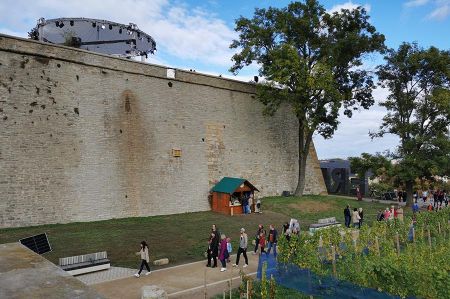 The Petersberg was probably inhabited by Stone Age people thousands of years before Christ. Due to the renovated buildings in the 1990s, it is difficult to carry out actual excavations, but various finds indicate the described settlement. A few centuries before Christ the Celts and Germanic tribes followed, who probably used the Petersberg as a rampart, refuge and place of worship. In the middle of the first millennium, after their victory over the Old Thuringians, the Franks invaded Thuringia and probably had a royal palace built on the Petersberg with an initial spiritual settlement, later a collegiate foundation. Under Charlemagne, a seat for a royal messenger was built on the hill, whose main task was to protect the royal road (via regia) that ran through Erfurt. In 755, the missionary Boniface united the diocese of Erfurt, which he had founded shortly before, with the diocese of Mainz.
The Petersberg was probably inhabited by Stone Age people thousands of years before Christ. Due to the renovated buildings in the 1990s, it is difficult to carry out actual excavations, but various finds indicate the described settlement. A few centuries before Christ the Celts and Germanic tribes followed, who probably used the Petersberg as a rampart, refuge and place of worship. In the middle of the first millennium, after their victory over the Old Thuringians, the Franks invaded Thuringia and probably had a royal palace built on the Petersberg with an initial spiritual settlement, later a collegiate foundation. Under Charlemagne, a seat for a royal messenger was built on the hill, whose main task was to protect the royal road (via regia) that ran through Erfurt. In 755, the missionary Boniface united the diocese of Erfurt, which he had founded shortly before, with the diocese of Mainz.
The archbishop of the diocese of Mainz converted the collegiate chapter on the Petersberg into a monastery for Benedictines in 1060, and thus the monastery of St. Peter and Paul (Peterskloster) was created. After a city fire destroyed the complex, the monastery was rebuilt at the beginning of the 12th century together with a new monastery church, the Peterskirche. In the decades that followed, the monastery served as accommodation for German emperors and kings on several occasions due to its close relationship with the royal palace on the Petersberg next door.
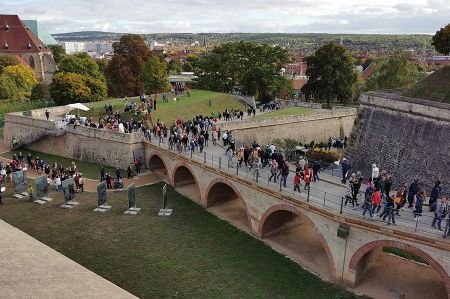 During the Thirty Years' War, the Petersberg was occupied for a few years by the Swedes, who had immediately recognized its strategic location. Under the Elector and Archbishop Johann Philipp von Schönborn, the Petersberg site was expanded into a city fortress, the Petersberg Citadel, in the middle of the 17th century. From 1802 to 1806, the Petersberg was used as a citadel by Prussian troops, and from 1806 to 1814 by French troops. With the Congress of Vienna in 1815, the Petersberg and Erfurt finally became part of the Kingdom of Prussia. The Peters Monastery was largely destroyed during the siege of 1813, and only the Peters Church has survived to this day, albeit in a reduced form.
During the Thirty Years' War, the Petersberg was occupied for a few years by the Swedes, who had immediately recognized its strategic location. Under the Elector and Archbishop Johann Philipp von Schönborn, the Petersberg site was expanded into a city fortress, the Petersberg Citadel, in the middle of the 17th century. From 1802 to 1806, the Petersberg was used as a citadel by Prussian troops, and from 1806 to 1814 by French troops. With the Congress of Vienna in 1815, the Petersberg and Erfurt finally became part of the Kingdom of Prussia. The Peters Monastery was largely destroyed during the siege of 1813, and only the Peters Church has survived to this day, albeit in a reduced form.
After that, it was one of the central military sites in the region until the 1960s, with minor interruptions.
By the way: To get to know the complex better, there is an exciting rally on the Petersberg at the citadel, where you have to answer some tricky questions. An overview map available in the visitor centre should help you answer the questions and discover the Petersberg Citadel in your own way! When all the questions have been answered, a little surprise awaits you in the visitor centre of the Petersberg Citadel!
Please read as well:
Railway mail waggon in the Dahlhausen Railway Museum
Elbasan - After Romans and Byzantines, Ottomans arrived
-
 Hiking to Petersberg Citadel in Erfurt
Hiking to Petersberg Citadel in Erfurt
Hiking to Petersberg Citadel in Erfurt
Hiking to Petersberg Citadel in Erfurt
-
 Hiking to Petersberg Citadel in Erfurt
Hiking to Petersberg Citadel in Erfurt
Hiking to Petersberg Citadel in Erfurt
Hiking to Petersberg Citadel in Erfurt
-
 Hiking to Petersberg Citadel in Erfurt
Hiking to Petersberg Citadel in Erfurt
Hiking to Petersberg Citadel in Erfurt
Hiking to Petersberg Citadel in Erfurt
-
 Hiking to Petersberg Citadel in Erfurt
Hiking to Petersberg Citadel in Erfurt
Hiking to Petersberg Citadel in Erfurt
Hiking to Petersberg Citadel in Erfurt
-
 Hiking to Petersberg Citadel in Erfurt
Hiking to Petersberg Citadel in Erfurt
Hiking to Petersberg Citadel in Erfurt
Hiking to Petersberg Citadel in Erfurt
-
 Hiking to Petersberg Citadel in Erfurt
Hiking to Petersberg Citadel in Erfurt
Hiking to Petersberg Citadel in Erfurt
Hiking to Petersberg Citadel in Erfurt
-
 Hiking to Petersberg Citadel in Erfurt
Hiking to Petersberg Citadel in Erfurt
Hiking to Petersberg Citadel in Erfurt
Hiking to Petersberg Citadel in Erfurt
-
 Hiking to Petersberg Citadel in Erfurt
Hiking to Petersberg Citadel in Erfurt
Hiking to Petersberg Citadel in Erfurt
Hiking to Petersberg Citadel in Erfurt
-
 Hiking to Petersberg Citadel in Erfurt
Hiking to Petersberg Citadel in Erfurt
Hiking to Petersberg Citadel in Erfurt
Hiking to Petersberg Citadel in Erfurt
https://www.alaturka.info/en/germany/thuringia/6705-citadel-on-the-petersberg-a-highlight-when-visiting-erfurt#sigProId88158241e4
